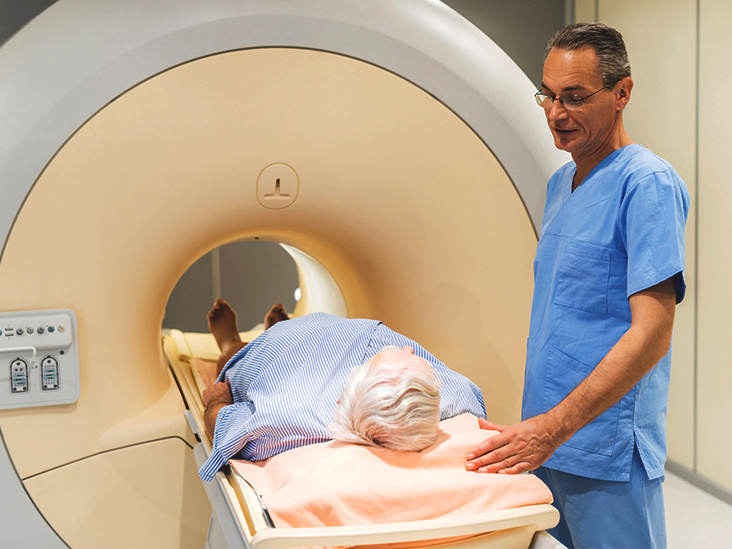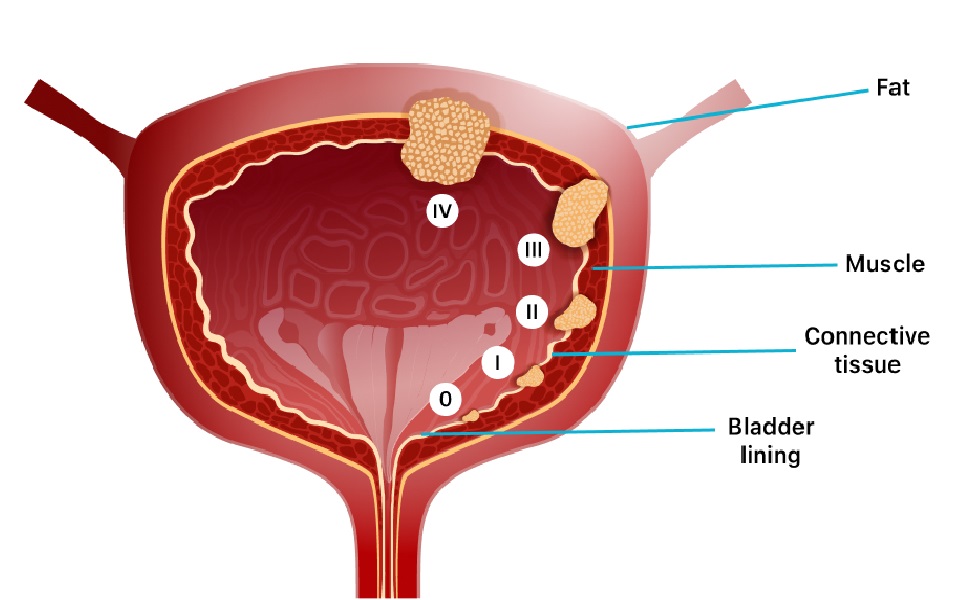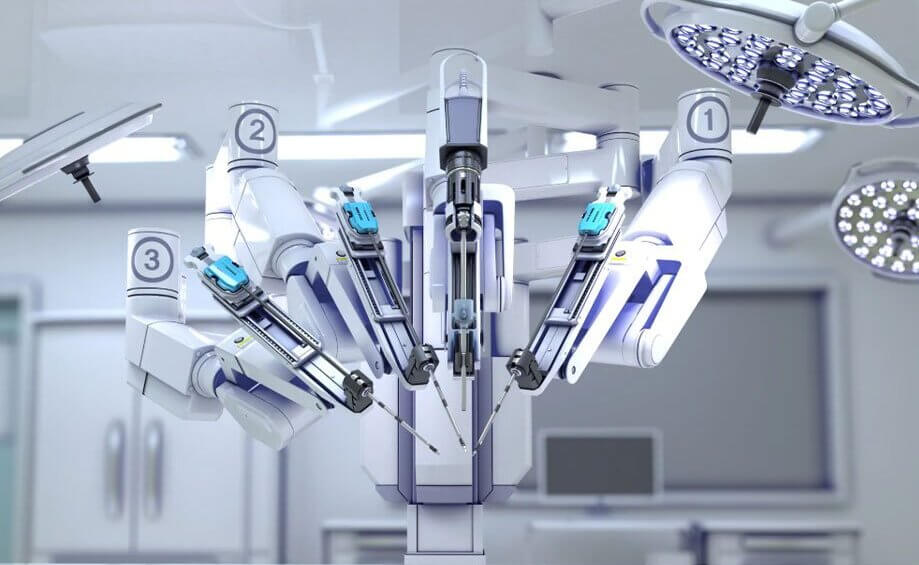
Bladder cancer is a malignant tumor of the urinary bladder that occurs due to the abnormal growth of mutated cells. Over time, such cells displace and replace healthy tissues of the body, spreading metastases throughout the body. In 90% of cases, cancer forms from the lining of the bladder (urothelium). A family history of bladder cancer increases the risk of developing the disease.

To rule out bladder cancer or detect it at an early stage of development, it is necessary to undergo regular check-up examinations. This is a comprehensive diagnosis of the whole body, which includes urological and oncological indicators. Leave a request on the MedTour platform to make an appointment with the clinic for a check-up examination.
Causes of bladder cancer
Doctors around the world have not agreed on what causes bladder cancer. According to the US National Cancer Institute (NCI), there are several known triggers that increase the likelihood of developing the disease. These include:
- Smoking. Both active and passive smoking are dangerous. Carcinogens from tobacco smoke enter the bloodstream, are filtered out by the kidneys and sent with urine to the bladder.
- Chemical substances. Frequent and prolonged exposure to certain chemicals while working in various industries increases the risk of bladder cancer. These substances include: paints, aniline dyes, petroleum products, etc.
- Genetic mutations: HRAS, RB1, PTEN/MMAC1, NAT2, GSTM1.
- Inflammatory (cystitis) and/or infectious (schistosomiasis) diseases of the bladder.
Other risk factors for bladder cancer include:
- A positive family history (the presence of bladder cancer in closest relatives);
- Radiation therapy in the treatment of malignant diseases of the pelvic organs: colorectal cancer, prostate cancer, cervical cancer;
- Certain medicines.

Contacting the MedTour coordinator will allow you to learn about modern methods of diagnosis and treatment of bladder cancer in foreign clinics. With timely detection and high-quality treatment, patients experience long-term remission and a chance for full recovery.
Bladder cancer symptoms
The urinary bladder is the organ that stores and expels urine. Therefore, the symptoms of bladder cancer are closely related to changes in the properties of urine and the characteristics of urination.
Early bladder cancer often causes no symptoms. The first symptoms and signs of the disease in the later stages may be:
- Blood in the urine (hematuria) – in 90% of patients, there is a reddish or brown discoloration of urine due to the presence of red blood cells;
- Frequent urge to urinate in small portions (pollakiuria) – with an increase in tumor size, the capacity of the bladder decreases, respectively, urine accumulates in smaller quantities;
- Pain during urination (stranguria).
In advanced stages of bladder cancer with spread of metastases, the following symptoms occur:
- Pain in the lower abdomen, in the pelvic area;
- Bone pain;
- Weight loss without changes in diet;
- Swollen lymph nodes;
- Swelling of the legs.

If you have blood in your urine or other symptoms of bladder cancer, see your doctor right away. Most often, the disease manifests itself in advanced stages, which complicates treatment. To make an appointment with an oncologist for a consultation, leave a request on the MedTour platform. Our coordinating doctor will help you choose a clinic and make an appointment with a specialist.
Diagnosis of bladder cancer

To make an accurate diagnosis, the doctor will prescribe a comprehensive examination, which will include:
- Cystoscopy. Under local or general anesthesia, the doctor inserts a special instrument with a camera (cystoscope) through the urethra to examine the inside of the bladder. Cystoscopy helps the doctor assess how deep the tumor has penetrated into the lining of the bladder. During this procedure, the doctor can remove suspicious tissue and then examine it for the presence of cancer cells in the laboratory.
- Biopsy. During a cystoscopy, the doctor will take a sample of suspicious tissue to examine under a microscope.
- Urine cytology –laboratory examination of urine for the presence of cancer cells.
- Blood and urine analysis.
- Ultrasound of the bladder.
- Intravenous urography (IVU). X-ray examination of the urinary tract using a contrast agent injected through a vein. The contrast enters the kidneys, ureters, and bladder. This helps the doctor identify areas that may be cancerous.
Examples of the cost of biopsy in leading clinics in the world:
- Turkey – $1 200;
- Germany – $1 200;
- Israel – $1 300;
- Spain – $1 600.
When a diagnosis of bladder cancer is confirmed, the doctor will prescribe other tests to determine if the cancer has spread to other organs. These examinations are:
- Chest x-ray;
- Ultrasound examination of the liver;
- CT or MRI of the abdomen;
- Bone scintigraphy (if there is a suspicion of a running process and spread of bone metastases).
Examples of the cost of PET-CT in the world’s leading clinics:
- Turkey – от $800;
- Ukraine – от $700;
- Israel – от $1 300;
- Germany – от $2 400.
Bladder cancer survival
Urothelial cancer occurs in 90% of cases of bladder cancer. Squamous cell carcinoma accounts for about 4-5% of all bladder cancer cases. Adenocarcinoma of the bladder accounts for about 2% of bladder cancer cases.
According to the American Cancer Society (ACS), the 5-year survival rate for bladder cancer at various stages is:
- Stage 0 – 98%;
- Stage 1 – 88%;
- Stage 2 – 63%;
- Stage 3 – 46%;
- Stage 4 – 15%.

A multidisciplinary approach to the treatment of bladder cancer increases the effectiveness of therapy and provides a favorable prognosis for the patient. Bladder cancer requires competent treatment under the supervision of an oncourologist, surgeon, pathologist, radiologist. This approach to treatment is practiced by specialists from foreign hospitals.
Bladder cancer stages

To describe the stage of bladder cancer, domestic and foreign doctors use the international classification system TNM. With her help, doctors draw up an effective treatment plan that matches the stage of the disease.
The TNM system describes the size, location of the neoplasm and its spread to other parts of the body:
- T – describes the size of the tumor;
- N – indicates damage to the lymph nodes;
- M – indicates the presence of metastases.
According to the TNM classification, bladder cancer has several stages:
1
Stage 0 (zero)
The neoplasm has not spread beyond the bladder mucosa. The tumor is small in size, without metastases.
- Stage 0a – the tumor has grown on the surface of the inner lining of the bladder, is easily treatable. This type of bladder cancer is called non-invasive papillary urothelial carcinoma.
- Stage 0is – carcinoma in situ. The tumor is also located on the inner lining of the bladder, but has a high grade of malignancy.
1
Stage 1
The tumor has gone beyond the mucous membrane, but has not reached the muscle and fat layer of the bladder, lymph nodes and other organs. This type of bladder cancer is called non-muscle invasive cancer.
1
Stage 2
The tumor has spread to the muscles of the bladder. This type of bladder cancer is called muscle invasive cancer.
1
Stage 3
The tumor has grown through the muscle layer to the adipose tissue that surrounds the bladder. There may be cancerous damage to the lymph nodes and organs in the vicinity of the bladder.
- Stage 3a – the spread of cancer to nearby organs (prostate, vagina or uterus). There is no damage to the lymph nodes, or the malignant process has affected one node.
- Stage 3b – cancer cells have reached two or more lymph nodes.
1
Stage 4
The spread of the tumor beyond the walls of the bladder.
- Stage 4a – the neoplasm has grown beyond the pelvis, to other organs and parts of the body, as well as lymph nodes.
- Stage 4b – cancer has invaded the lymph nodes and metastasized to other parts of the body.
Types of bladder cancer
The type of bladder cancer is determined by the type of cell from which the malignant process began. Doctors identify the following types of bladder cancer:
- Urothelial (90% of cases) – develops from urothelial cells, which are able to stretch depending on the fullness of the bladder. The most common type of bladder cancer is urothelial carcinoma.
- Squamous cell (4-5% of cases) – is formed when the flat cells of the bladder are negatively affected by parasites, infectious or inflammatory processes.
- Adenocarcinoma (up to 2% of cases) – arises from the glandular cells of the mucous membrane of the bladder.
- Small cell carcinoma is extremely rare (in 0.5% of cases).
In addition to bladder cancer, bladder sarcoma is isolated – an aggressive tumor that forms from the fatty or muscle layer of the bladder.
Kinds of bladder cancer
In addition to describing the extent and cell type of bladder cancer, doctors determine the type of cancer based on how deeply it has spread into the bladder wall.
Doctors identify the following types of bladder cancer:
- Non-invasive (superficial or early). Cancer cells are found only in the mucous membrane of the bladder, not germinating further. This type of cancer includes:
- Papillary non-invasive cancer of low and high grade;
- Carcinoma in situ (CIS).
- Invasive. The tumor grows into the deeper layers of the bladder or outside the organ.
- Non-muscle invasive cancer. Corresponds to the 1st stage of bladder cancer. The tumor did not grow beyond the mucous layer of the bladder;
- Muscle-invasive cancer. The tumor has invaded the muscle wall of the bladder. Also, cancer cells can move to adipose tissue and other organs of the body, spreading metastases.
Bladder cancer treatment

Treatment of bladder cancer is most often combined, i.e. doctors use several techniques that improve the result of therapy.
The treatment plan for bladder cancer is developed by a team of doctors individually and depends on many factors, including:
- The age of the patient;
- The extent of the cancer;
- The type and kind of cancer;
- The number of tumors;
- Symptoms;
- The general condition of the patient.
The main therapies used for bladder cancer are:
- Surgery;
- Chemotherapy;
- Immunotherapy;
- Radiation therapy;
- Targeted therapy.
Surgery
Surgery for bladder cancer can be performed in three ways: open surgery, laparoscopy, and surgery with the Da Vinci robotic system. There are several types of surgical treatment for bladder cancer:
Transurethral resection (TUR) of the tumor
The doctor removes the growth through the urethra using a special instrument (cystoscope). The operation is performed under general anesthesia and lasts from 15 minutes to 1.5 hours. The advantages of TUR are its safety and reliability, as well as the recovery time. The patient can go home the same day the surgery was performed.
Cystectomy – removal of the bladder
A radical cystectomy is the removal of the entire bladder. For men, the prostate gland and part of the urethra are also removed, for women – the uterus, fallopian tubes (sometimes the ovaries and part of the vagina).
Partial cystectomy – removal of part of the bladder. Most often, this operation is performed with adenocarcinoma of the bladder.
Examples of the cost of an operation with a Da Vinci robot in leading clinics in the world:
- Turkey – $14 000;
- Germany – $22 300;
- Israel – $24 000.
Chemotherapy
Intravesical chemotherapy
Medicines are injected through the urethra into the bladder using a catheter. The medicine is in the bladder for 1-2 hours, after which it is removed naturally or through a catheter.
Immunotherapy
The introduction of BCG into the bladder.
The introduction of BCG (tuberculosis vaccine) stimulates the body’s immune system. It helps slow down or stop the growth of cancer cells. BCG is injected into the bladder through a catheter.
Interferons
Immunotherapy drugs that are used as intravesical therapy. Sometimes the doctor can combine the intake of interferons with BCG.
Immune checkpoint inhibitors
Often doctors use this type of treatment for urothelial bladder cancer or urothelial carcinoma when chemotherapy has failed.
Radiation therapy
Radiation therapy is usually given at the same time as chemotherapy. The doctor selects the radiation therapy regimen based on the characteristics of the bladder cancer, its size and distribution.
Targeted therapy
It is a treatment that blocks the growth and division of cancer cells by acting on the cell structures of the tumor. Targeted therapy does not harm healthy cells.

Modern methods of oncosurgery and radiotherapy allow doctors of foreign clinics to supplement the treatment regimens for patients with bladder cancer. All innovative methods are aimed at reducing the symptoms of the disease during therapy and contribute to a complete cure. To sign up for the best clinic for the treatment of bladder cancer, leave a message to the medical coordinator of MedTour.
Treatment regimens for bladder cancer by stage
Stage 0 (zero):
- Transurethral resection of the bladder tumor, after which, if necessary, intravesical chemotherapy or intravesical BCG therapy is performed;
- Cystectomy (partial or radical).
Stage 1:
- Transurethral resection of the bladder tumor;
- Intravesical chemotherapy or intravesical BCG therapy;
- Cystectomy (partial or radical).
Stage 2-3:
- Cystectomy (partial or radical);
- Chemotherapy (often in combination with radiation therapy);
- Lymphadenectomy (removal of lymph nodes).
Stage 4:
- Chemotherapy;
- Radical cystectomy;
- Chemotherapy combined with radiation therapy;
- Immunotherapy;
- Targeted therapy;
- Palliative care.
How much does bladder cancer treatment cost abroad?
The cost of bladder cancer treatment is individual for each patient. The final cost of bladder cancer therapy is influenced by many factors:
- Selection of the country and clinic for the treatment;
- Experience and qualifications of a doctor;
- A set of prescribed diagnostic procedures;
- Stage, type and type of cancer;
- The age and general health of the patient;
- Choice of treatment tactics;
- Postoperative rehabilitation.
Examples of the cost of diagnostics and treatment in clinics in different countries
Bladder ultrasound:
- Turkey – $45;
- Israel – $300;
- Germany – $350.
Immunotherapy:
- Turkey – $2 500;
- Israel – $1 250;
- Germany – $1 300.
Targeted therapy:
- Turkey – $3 000;
- Israel – $1 250;
- Turkey – $1 200.
Cystectomy (removal of the bladder):
- Turkey – $10 000;
- Israel – $20 000;
- Turkey – $22 300.

In order to choose a country and clinic for the treatment of bladder cancer, it is important to focus on the specifics of providing medical services to foreign patients. A key role in the prognosis for recovery is played by the ability to organize a trip on time. To get the full range of medical services at the best hospital for the treatment of bladder cancer, leave a message on the MedTour platform.
Frequently Asked Questions
1
Stage 0 (zero)
The neoplasm has not spread beyond the bladder mucosa. The tumor is small in size, without metastases.
- Stage 0a – the tumor has grown on the surface of the inner lining of the bladder, is easily treatable. This type of bladder cancer is called non-invasive papillary urothelial carcinoma.
- Stage 0is – carcinoma in situ. The tumor is also located on the inner lining of the bladder, but has a high grade of malignancy.
1
Stage 1
The tumor has gone beyond the mucous membrane, but has not reached the muscle and fat layer of the bladder, lymph nodes and other organs. This type of bladder cancer is called non-muscle invasive cancer.
1
Stage 2
The tumor has spread to the muscles of the bladder. This type of bladder cancer is called muscle invasive cancer.
1
Stage 3
The tumor has grown through the muscle layer to the adipose tissue that surrounds the bladder. There may be cancerous damage to the lymph nodes and organs in the vicinity of the bladder.
- Stage 3a – the spread of cancer to nearby organs (prostate, vagina or uterus). There is no damage to the lymph nodes, or the malignant process has affected one node.
- Stage 3b – cancer cells have reached two or more lymph nodes.
1
Stage 4
The spread of the tumor beyond the walls of the bladder.
- Stage 4a – the neoplasm has grown beyond the pelvis, to other organs and parts of the body, as well as lymph nodes.
- Stage 4b – cancer has invaded the lymph nodes and metastasized to other parts of the body.




